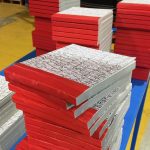Summarising our binding styles
Quarter Binding
A type of bookbinding in which the material on the spine is different to the front and back covers. The cover may be hard or soft, depending on the thickness of the cardboard used. The pages and covers are cut to the size required, then stitched (stapled) two or more times down the spine edge depending on thickness and paper weight. The spine and staples are covered with cloth binding tape for a neat finish. The result is a sturdy binding, however the book will not lie flat when opened.
Typically used for docket books, NCR (No Carbon Required) books. Learn more about quarter binding.
Saddle Stitch Binding
The pages and covers are folded, then stapled through the centre fold along the spine. This style is suitable for both self-covered books (where the cover stock, or paper, is the same as the text), and books with separate covers. Generally the maximum number of pages varies depending on weight and bulk of the paper used.
Typically used for magazines, small soft covered books, brochures. Learn more about saddle stitching.
Spiral Wire Binding
Also called Coil Binding, this method joins the pages and cover of a book using a durable plastic or metal coil that is shaped like a long spring. The coil is inserted and twisted through small holes or slots punched along the spine edge of the book. This type of binding allows the printed document to lie flat or double under.
Typically used for technical manuals, notebooks, calendars. Learn more about spiral wire binding.
Wiro Binding
Also called Double Loop and Twin Loop Wire, this binding holds the pages of the book in place by a double loop wire inserted through holes on the spine edge. It does not spiral through the book, rather it creates a wire comb. Like spiral binding, the pages lie flat when opened and can be doubled under.
Typically used for reference books, reports, cook books, proposals. Learn more about wiro.
Plastic Comb Binding
This type of binding employs plastic combs which are inserted into slots punched along the spine of a stack of printed, trimmed sheets. It can be used for manuals up to about 3 inches thick. The style allows the pages to lie flat when open, and pages can be added or subtracted. It is one of the cheapest binding options, however as they are usually assembled by hand they can be costly for large quantities.
Typically used for reports, presentations, documents. Learn more about plastic comb binding.
Pad Binding
Also called Glue Binding, this is a form of binding where padding compound (adhesive) is applied with a brush to one edge of a stack of paper, gluing the stack together on that edge. The glue can be coloured as desired before application. When the glue is dry, pages can be torn out easily and cleanly. This is not a permanent style of binding and is used where pages are meant to be torn out.
Typically used for easy tear-off notepads, desk pads, scribble pads, drawing pads. Learn more about padding.
Perfect Binding, Burst Binding
The most common styles used for binding paperback books. In both these methods, hot melt adhesive is applied to the spine of a block of printed sheets. The cover is then affixed to the spine edge. While the finished products look the same, a different process is required in the spine preparation. Burst Binding requires the spine to be notched, which is done during the folding process using a special burst notching attachment. During the binding process the glue penetrates the notches into the centre of the section. With Perfect Binding, the spine is trimmed and prepared in the binding process and the book is bound as single sheets.
Typically used for paperback books, large magazines, user manuals. Learn more about perfect binding.


